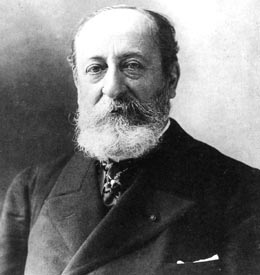Composer: Camille Saint-Saëns
- Piano Concerto No. 2 in G Minor, Op. 22
- Wedding Cake, Op. 76
- Allegro appassionato, Op. 70
- Piano Concerto No. 1 in D Major, Op. 17
- Rhapsodie d'Auvergne, Op. 73
- Africa, Op. 89
Alexandre Kantorow, piano
Tapiola Sinfonietta
Jean-Jacques Kantorow, conductor
Date: 2022
----------------------------------------------------------------------------
The prospect of a recording of any of Saint-Saëns’s works for piano and orchestra is always a delightful one. You know you are in for an hour or more of music that lifts the spirits with its joie de vivre and inexhaustible supply of memorable ideas. The prospect is enhanced, on this occasion, by the same soloist, orchestra and conductor who gave us Concertos Nos 3, 4 and 5 back in the long-ago pre-pandemic days, a superb disc that won the accolade of an Editor’s Choice (6/19).
This one should be heading the same way, despite some reservations about the first movement of Piano Concerto No 2. Of course, there is more than one way of interpreting such requests as andante sostenuto and ad libitum (for the solo passage that begins the work) and crotchet=54 (for the orchestra’s entry), but the Kantorows, father and son, take both sections far too ponderously. Perhaps Alexandre had been playing too much Brahms (I note that the G minor Concerto was the only work here recorded in 2021; the remainder come from sessions in 2018 and 2020). Also, after the cadenza, at 8'06" the piano hits a low octave B natural followed by a semiquaver rest. In what might be an editing error the music simply stops; four bars later, there is a right-hand octave onslaught marked agitatissimo. It certainly is not that here. The end result is a first movement that lasts nearly two and a half minutes longer than benchmark accounts by Darré, Hough, Chamayou and young Benjamin Grosvenor. The popular Scherzo movement is superb, and the finale is taken at an exciting true presto (though there is an unscheduled meno mosso adjustment at 2'02", just after fig D).
None of these moments is significant enough to mar one’s enjoyment of the music-making. Quite the opposite. There is a palpable exuberance and joy in the way these works come across, none more so in the four concertante works for piano and orchestra, the effervescent Wedding Cake caprice, Rhapsodie d’Auvergne (an early use of French folk song, years ahead of d’Indy and Canteloube), Allegro appassionato (not the better-known work for cello with the same title) and Africa (who else was using North African folk music at this time?).
The album also includes the woefully neglected Piano Concerto No 1, with its opening horn call reminding us of the end of Chopin’s Second Piano Concerto. If the rousing finale doesn’t hook you, then try the haunting slow movement with its prescient passages not only of its successor but of the kind of impressionistic writing that anticipates Ravel by half a century.
It’s a terrific programme – unique for a single disc, so far as I know – clocking in at 85 minutes, and another feather in the cap of the gifted soloist and his partners. The recording offers an exemplary balance between piano and orchestra in a realistic acoustic, and comes with a good booklet – but was the original version of the Second Concerto really for pedal piano?
-- Jeremy Nicholas, Gramophone
More reviews:
ClassicsToday ARTISTIC QUALITY: 9 / SOUND QUALITY: 10
http://www.musicweb-international.com/classrev/2022/Jun/Saint-Saens-PCs-BIS2400.htm
http://www.musicweb-international.com/classrev/2022/Jun/Saint-Saens-PCs-BIS2400.htm
----------------------------------------------------------------------------
Camille Saint-Saëns (9 October 1835 – 16 December 1921) was a French composer, organist, conductor and pianist. Saint-Saëns was a musical prodigy, making his concert debut at the age of ten. He was a successful freelance pianist and composer, in demand in Europe and the Americas. His best-known works include his concertos, his 3rd symphony, Danse macabre and The Carnival of the Animals. Saint-Saëns was enthusiastic for the most modern music of the day, although his own compositions were generally within a conventional classical tradition. Saint-Saëns' students included Gabriel Fauré.
http://en.wikipedia.org/wiki/Camille_Saint-Sa%C3%ABns***
Alexandre Kantorow (born 20 May 1997) is a French pianist whose father is the violinist and conductor Jean-Jacques Kantorow. He studied with Pierre-Alain Volondat, Igor Lazko, Frank Braley and Haruko Ueda, and is currently studying with Rena Shereshevskaya at the École Normale de Musique de Paris. Described by Gramophone as a "fire-breathing virtuoso with a poetic charm" and by Fanfare as "Liszt reincarnated", he won the first prize, gold medal, and Grand Prix at the 16th International Tchaikovsky Competition in 2019, being the first French winner in the history of the competition.
https://en.wikipedia.org/wiki/Alexandre_Kantorow
Alexandre Kantorow (born 20 May 1997) is a French pianist whose father is the violinist and conductor Jean-Jacques Kantorow. He studied with Pierre-Alain Volondat, Igor Lazko, Frank Braley and Haruko Ueda, and is currently studying with Rena Shereshevskaya at the École Normale de Musique de Paris. Described by Gramophone as a "fire-breathing virtuoso with a poetic charm" and by Fanfare as "Liszt reincarnated", he won the first prize, gold medal, and Grand Prix at the 16th International Tchaikovsky Competition in 2019, being the first French winner in the history of the competition.
https://en.wikipedia.org/wiki/Alexandre_Kantorow
----------------------------------------------------------------------------
FLAC, tracks
Links in comment
Enjoy!



Choose one link, copy and paste it to your browser's address bar, wait a few seconds (you may need to click 'Continue' first), then click 'Free Access with Ads' / 'Get link'. Complete the steps / captchas if require.
ReplyDeleteIf you are asked to download or install anything, IGNORE, only download from file hosting site (mega.nz).
If MEGA shows 'Bandwidth Limit Exceeded' message, try to create a free account.
https://link-hub.net/610926/saint-saens-concertos-1-2
or
https://uii.io/mntEQhgNQ
or
https://exe.io/qhWjzj
¡Muchas gracias, Ronald!
ReplyDelete